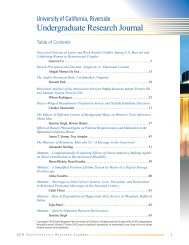2010 - Undergraduate Research, Scholarship and Creative Activity
2010 - Undergraduate Research, Scholarship and Creative Activity
2010 - Undergraduate Research, Scholarship and Creative Activity
Create successful ePaper yourself
Turn your PDF publications into a flip-book with our unique Google optimized e-Paper software.
Moreover, Wood missed critical opportunities to<br />
refine <strong>and</strong> challenge his underst<strong>and</strong>ing of the<br />
role that gender plays cross-culturally. I will<br />
examine Wood‘s assumptions while arguing<br />
that, by failing to take a critical approach to his<br />
cultural biases <strong>and</strong> academic framework, Wood<br />
reproduces the gender essentialism he sought to<br />
avoid. By exp<strong>and</strong>ing the scope of his inquiries<br />
into Gabra society <strong>and</strong> offering alternative<br />
interpretations of what he observed, I will<br />
demonstrate how Wood‘s imposition of 'gender<br />
structure' on Gabra society does not capture<br />
Gabra life or thought.<br />
Behavioral Adaptations of Houseflies (Musca<br />
domestica L.) to Avoid the Insecticide<br />
Imidacloprid<br />
Daniel Wasik, Environmental Science<br />
Mentor: Alec Gerry<br />
Department of Entomology<br />
Two populations of houseflies (Musca<br />
domestica L.) were starved for 24 hours <strong>and</strong><br />
subjected to a choice feeding assay. The<br />
resistant colony was captured in 2008 at a field<br />
site in southern California <strong>and</strong> is shown to be<br />
resistant to the insecticide imidacloprid. The<br />
susceptible colony is a laboratory strain that has<br />
never been introduced to imidacloprid. Using an<br />
enclosed arena with imidacloprid insecticidetreated<br />
<strong>and</strong> untreated sucrose provided as food,<br />
fly behavior was monitored using video cameras<br />
to determine if resistant flies showed an<br />
increased detection <strong>and</strong> avoidance of the treated<br />
food source relative to the susceptible flies. Both<br />
colonies exhibited no preference to l<strong>and</strong>ing on<br />
one food dish over the other (p > 0.05). Both the<br />
colonies disengaged the treated dish more often<br />
than the untreated dish but the resistant colony<br />
disengaged significantly more often than the<br />
susceptible colony (P=0.024). The susceptible<br />
colony fed on both treated <strong>and</strong> untreated equally<br />
(P=.25) but the resistant colony almost solely<br />
fed on the untreated dish <strong>and</strong> not the treated<br />
dish. (P=.0078). Imidacloprid acts as a contact<br />
irritant causing locomotion stimulation in both<br />
colonies but the stimulation is significantly<br />
stronger in the resistant colony.<br />
Variation in swimming performance in<br />
relation to sex, sexually selected traits,<br />
<strong>and</strong> reproductive allocation<br />
Danielle Wickman, Biology<br />
Contributor: Christopher E. Oufiero<br />
Mentors: David Reznick, Ted Garl<strong>and</strong><br />
Department of Biology<br />
My project is an Upper Division Honors Thesis<br />
that is focused on determining what influences<br />
locomotor performance (sprint speed <strong>and</strong><br />
endurance) between both sexes within three<br />
species of Xiphophorus fish that vary in sword<br />
length <strong>and</strong> reproductive allocation. The three<br />
species examined were X. nigrensis, X. helleri,<br />
<strong>and</strong> X.variatus. We used intraspecific variation<br />
among each of the species to determine what<br />
traits might account for variation in swimming<br />
performance. It was predicted that sword length<br />
will have a negative effect on performance, but<br />
other traits such as tail, heart, or gill mass may<br />
have a positive effect, compensating for the<br />
length of the sword. In females, locomotor<br />
performance may be affected by their amount of<br />
reproductive allocation. Bigger broods, bigger<br />
offspring or a combination may negatively affect<br />
performance. Also, similar to males, tail, heart,<br />
or gill mass may compensate. Sprint Speed was<br />
measured by chasing a fish down a racetrack<br />
lined with twelve pairs of photocells that<br />
recorded maximum velocity. Endurance was<br />
measured by examining critical swimming<br />
speed, which is a ramped velocity test. Organs<br />
were initially dissected out after being preserved<br />
for several months, blotted dry, weighed, <strong>and</strong><br />
recorded for investigation. We found significant<br />
differences among the three species for<br />
endurance <strong>and</strong> sprint speed, with the medium<br />
length sworded species (X. nigrensis) having the<br />
lowest endurance <strong>and</strong> highest sprint speed after<br />
controlling for body size. X. nigrensis was also<br />
the only species to exhibit differences in<br />
swimming performance between the sexes. Path<br />
analysis models were used to determine the<br />
effects of a single trait controlling other<br />
variables intraspecifically in each of the three<br />
species. It was found that sword length does not<br />
affect performance, but rather that ovary mass,<br />
or the extent of reproductive allocation does<br />
Fourth Annual UCR Symposium for <strong>Undergraduate</strong> <strong>Research</strong>, <strong>Scholarship</strong> <strong>and</strong> <strong>Creative</strong> <strong>Activity</strong><br />
48














